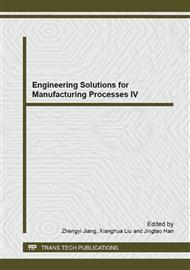[1]
QIE Yan-hui, WANG Xiu-hong, Liu Bo, BAI Li-jun. Optimal Design of Study of the Middle Pan Based on ANSYS Workbench. JOURNAL OF HEBEI UNIVERSITY OF TECHNOLOGY, Vol. 5(2010), pp.53-56.
Google Scholar
[2]
Cheng Di, Wang Chengguo. Research on Multi objective Optimization Design of Wheel Profile[D]. China Academy of Railway Sciences, (2011), pp.37-40.
Google Scholar
[3]
Bolchini Cristiana, Lanzi Pier Luca, Miele Antonio. A multi-objective genetic algorithm framework for design space exploration of reliable FPGA-based systems. 2010 IEEE World Congress on Computational Intelligence, WCCI 2010 - 2010 IEEE Congress on Evolutionary Computation, CEC 2010, (2010).
DOI: 10.1109/cec.2010.5586376
Google Scholar
[4]
Fan, Qin-Man. Multi-objective optimization design of vehicle transmission system based on Pareto optimal theory. 2009 2nd International Conference on Intelligent Computing Technology and Automation, ICICTA 2009, Vol. 3 (2009), pp.198-201.
DOI: 10.1109/icicta.2009.514
Google Scholar
[5]
Wong S.M. , Hobbs R.E. ,Onof C. An adaptive response surface method for reliability analysis of structures with multiple loading sequences. Structural Safety. 4, (2005), pp.287-308.
DOI: 10.1016/j.strusafe.2005.02.001
Google Scholar
[6]
V.V. Guaracho, N.M.S. Kaminari, M.J.J.S. Ponte, H.A. ponte. Central Composite experimental design applied to removal of lead and nickel from sand. Journal of Hazardous Materials, Vol. 172(2009), pp.1087-1092.
DOI: 10.1016/j.jhazmat.2009.07.100
Google Scholar
[7]
XIA Lian, CHEN Jing, HAN Jiang, FENG Yun. Dynamic and Static Multi-objective Optimization of Machine Tool Bed Based on Response Surface Method. Modular Machine Tool & Automatic Manufacturing Technique, Vol. 9(2012), pp.83-86.
Google Scholar
[8]
Udayakumar T., Raja K., Afsal Husain T.M., Sathiya P. Prediction and optimization of friction welding parameters for super duplex stainless steel (UNS S32760) joints. Materials and Design, Vol. 53(2014),P. 226-235.
DOI: 10.1016/j.matdes.2013.07.002
Google Scholar
[9]
Huang Jun, Zhou Qing. Study of the Vehicle Front-end Structure Fast Design for Pedestrian Leg form Protection[D]. Tsinghua University, (2013), pp.80-83.
Google Scholar
[10]
Bayindir Ismail Ugur; Mercan Engin, Korkmaz Emin Erkan. hybrid Multi-Objective Genetic Algorithm for Bandwidth Multi-Coloring Problem. Proceedings of the 2012 12th International Conference on Hybrid Intelligent Systems, HIS 2012, (2012).
DOI: 10.1109/his.2012.6421335
Google Scholar


